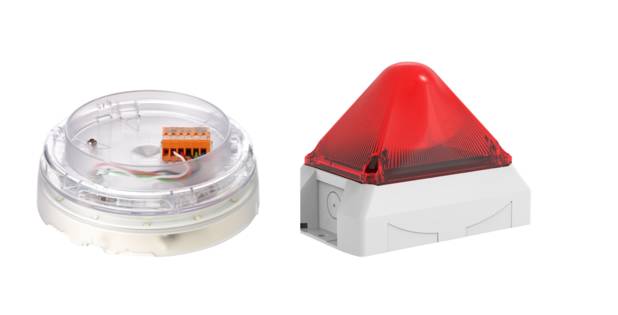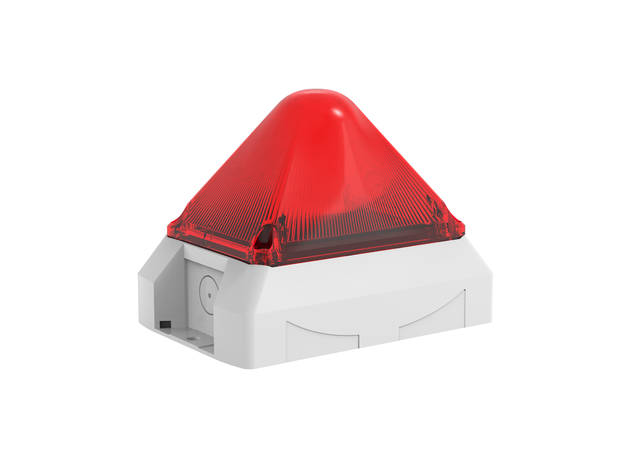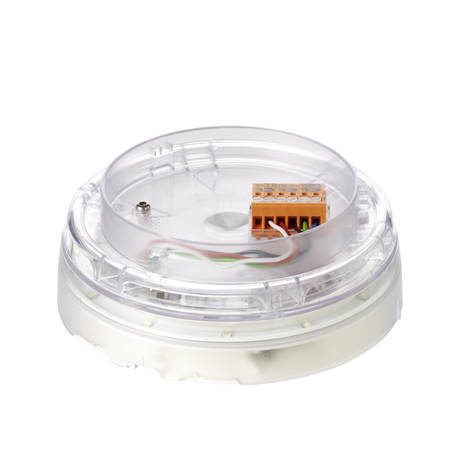Fire protection in accordance with VDE 0833-2 - changes relating to visual signaling devices in fire alarm systems
The provisions of the standard for visual signaling devices in fire alarm systems, DIN EN 54-23, are legally binding in Germany. The publication of the revised design and project planning standard DIN VDE 0833-2 in October 2017 removes the grey area which has existed hitherto and projects will be planned in accordance with the current requirements of the new product standard. The following article explains the significance of this development for suppliers, installers and designers of fire alarm systems.

The standard for visual signaling devices, EN 54-23, came into force in the Member States of the European Union on 1 January 2014. It will no longer be permitted to use visual and visual-audible signaling devices which were licensed for use in fire alarm systems before that unless they were already on the market. The requirements of the product standard EN54-23 have been implemented with the publication of the revised design and project planning rules stipulated in DIN VDE 0833-2. It describes clearly how many and in what way visual signaling devices should be planned for inclusion in a project and for the first time states clear requirements concerning their planning and arrangement.
As before, DIN VDE 0833-2 stipulates unequivocally that the operator of a system is responsible for the fire alert and alarm concept. As such, he or she must determine with the authorities responsible, the designer and possibly the installer of the fire alarm system (FAS) measures such as how to create an audible (and if relevant visual) alarm system to meet the requirements of certain areas.
The Two Senses Principle
The ZVEI 82019 fact sheet1 summarizes the principles and challenges of visual alarm systems: employees working in a standard industrial environment are constantly exposed to audible and visual stimuli which makes accurate attribution of signals difficult. Many industrial activities require that ear protectors or goggles are worn and this restricts hearing and view. Furthermore, increasing numbers of people worldwide suffer from hearing defects and for them a purely audible alerting system is not effective.
The aim of the Equality for Persons with Disabilities Act (Behindertengleichstellungsgesetz - BGG) is to eradicate and prevent the discrimination facing disabled persons and to grant them equal rights to participate in social and working life. This includes the right to self-rescue. The accessibility of buildings and systems for disabled people is also defined. Accessible building regulations are set out in DIN 18040-1. Depending on the status of implementation in building legislation in the federal states, the "two senses principle" should apply to alerting systems. As well as the established method of alerting with audible signaling devices, additional alerting can be provided by visual signaling devices.
The primary aim of fire alarm systems is to protect people and property. This applies to production sites as well as administrative and public buildings. Fire alarm systems in both cases fulfill their purpose of allowing fire to be detected at an early stage, irrespective of whether people are present or not, so that appropriate action can be taken without delay. Rescue service personnel can therefore intervene quickly and extinguish a fire before it has taken hold.
In an emergency such as a fire, it must be guaranteed that every person present in the affected area – even those with impaired ability to hear or see – are immediately and unambiguously alerted and evacuated as quickly as possible. This is usually done with a system of audible and/or visual signaling devices installed throughout the building.
Mandatory requirements for visual signaling devices
Fire alarm systems are stipulated in building legislation and their use is regulated under the special provisions for construction. The legal framework is a decisive factor in the planning and configuration of audible and/or visual signaling devices. Their design and components are set out in VDE 0833-2. The components are largely harmonized in the EN 54 series of European standards. For example, EN 54-3 (audible signaling devices) and EN 54-23 (visual signaling devices) stipulate the requirements that signaling devices must fulfill if they are to be used in fire alarm systems. They set out the general requirements of the devices and the technical parameters used to calculate coverage volumes (for audible signaling devices). They also specify the immediate determination and description of the coverage volume (for visual signaling devices) as part of the certification process.
The revision of DIN VDE 0833-2 sets out the planning and configuration of coverage volumes in accordance with the approval categories as per EN 54-23. There are definitions for three different approval categories and associated forms of coverage volume which have an impact on the number and installation location of signaling devices in the area to be reached by the signal. Depending on the product and the application, the choice of signaling color (a clear or a red cover) can have an effect on the coverage volume and therefore on the number of signaling devices required.
Actual coverage volumes defined for the first time
In EN 54-23, the devices are placed in three possible approval categories. The geometry of the coverage volume is specified for the "W" (wall installation) and "C" (ceiling installation) categories. On the other hand, Category "O" (open installation) allows the manufacturer to describe the coverage volume in any way or to design the best possible coverage volume for specific applications and constructions. This is stated 1:1 in the new sub-item 6.4.8 in VDE 0833-2 (visual signaling devices for alerting persons).
The product standard also requires the devices to deliver a specific light output and light distribution. For example, it specifies that throughout the coverage area a minimum light intensity of 0.4 lux/m² must be achieved under the defined measurements. Furthermore, visual signaling devices must emit white or red flashing lights at a frequency from 0.5 Hz to 2 Hz. For visual alarm systems, the individual coverage volumes in the relevant approval category must now be arranged so that they cover the whole of the space throughout which the signal is to be seen.
Significance of the alarm color
DIN VDE 0833-2 also stipulates the use of the permitted color. The preferred color for alarms is red. Currently in Germany, 90% of the alarms chosen have a red light. A clear light can be permitted in some circumstances, with the alarm system concept determined jointly by the operator and the authorities responsible. There can be good reasons to use a clear light, particularly in industrial settings. This is because almost every machine will have a red signaling device and this can lead to confusion and failure to identify a possible fire alarm clearly. Furthermore, signaling devices with a clear flashing light offer a larger coverage volume, which can allow fewer signaling devices to be used, thus cutting costs.
Making the right choice
The planning and configuring of audible and visual fire alarm systems must fulfill many conditions. They must not only comply with the standards, but also be economical and as effective as possible. The right choice of alerting solutions must be made for each application in accordance with VDE 0833-2. It is crucial that an alarm concept is drawn up in advance in order to define the hazardous areas. This must reflect the distinction between industrial applications and applications in public buildings, which each have their own requirements.
Industrial buildings normally have high ceilings and large surface areas which clearly define the coverage volume. In these cases, the use of signaling devices in the "O" category are recommended as they can be positioned with some flexibility enabling the coverage volume to be as wide as possible. The choice of light technology can also be crucial. Signaling devices with XENON technology, such as the models in Pfannenberg's PYRA® series (PYRA® X-S, PYRA® X-M and PYRA® X-L), as a rule cover a wider area than comparable products with different technologies and installation locations (categories "C" or "W").

Siemens uses Pfannenberg devices for its industrial applications as they are economical and easy to use in their properties. For example, visual signaling devices in the PYRA® series are used for their projects in the automotive industry or in steelworks. As a rule, these projects have high ceilings and large areas where it is necessary to use specialized signaling devices. Conventional systems are preferred for industrial situations as they offer more flexibility in terms of critical power consumption and despite requiring more cabling are a more economical solution. A well-known automobile manufacturer required a ceiling-mounted visual alarm system. The ceiling height was just under 10 meters. The PY X-M 10 SSM KL is the only signaling device suitable and licensed for this application. Offering coverage of an area measuring 405 m² on the ground, just a few of these devices allow a signal to be perceived even throughout a space with large dimensions. Intelligent bus systems are preferred for public buildings. Integrated loop signaling devices are particularly suitable in these cases, such as the FDSB221, FDSB228 or FDSB229 offered by Siemens. With single-point mounting, they are easily installed. Several challenges in a project in a school were solved in this way. First of all, it proved possible to use the existing cabling network for the fire alarm system. Secondly, this ensures that the alarm is less likely to fail. Downtime due to upgrades and modernizations in the relevant areas were reduced to a minimum. Integration in the FDNet intelligent bus system from Siemens is particularly easy because parameterization can be carried out with the software that puts the system into operation.

The most important change resulting from the new VDE 0833-2 for FSA suppliers, installers and planners is that every alerting solution must be planned individually. The focus is always on the actual coverage volume of the signaling device, which can be used to determine the device requirements. It is essential to take careful account of the manufacturer's information in order to avoid incorrect dimensioning or problems when the system is approved. Knowing the actual coverage volume of the signaling devices provides as much certainty as possible throughout the whole project phase and guarantees that the alarm system will be compliant with the standards, thus achieving the objectives and preventing costs from rising excessively.
1) ZVEI, Arbeitsgemeinschaft Errichter und Planer, Merkblatt 82019:2015-01, Einsatz von DIN EN 54-23 – Optische Signalgeber; Brandmeldeanlagen und Alarmierung, Frankfurt am Main, März 2015 - German Electrical and Electronic Manufacturers' Association, Installers and Designers Working Group, fact sheet 82019:2015-01, The Implementation of DIN EN 54-23 - Optical signaling devices; fire alarm systems and alerting, Frankfurt am Main, March 2015.
| Description | Language | Type | Size | Download |
|---|---|---|---|---|
Technical Report: VDE 0833-2Fire protection in accordance with VDE 0833-2: changes relating to visual signaling devices in fire alarm systems |
|
240 KB | Download |
